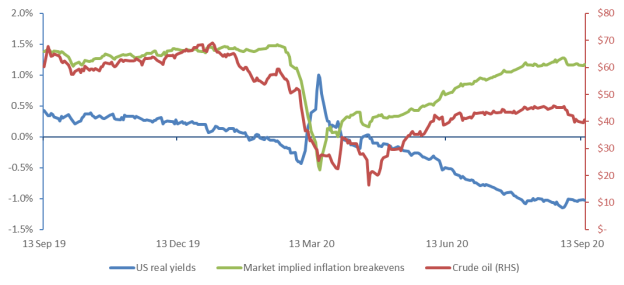PARTNER CONTENT by FIDELITY
This content was paid for and produced by FIDELITY
Fidelity Multi Asset Income team - Eugene Philalithis | George Efstathopoulous | Chris Forgan
In the wake of the pandemic, we have seen extraordinary large-scale global monetary stimulus efforts and a change in the stance of major central banks away from inflation targeting and towards inflation averaging to boost growth. The question of whether these policies will stimulate inflation or not remains a hot topic for investors across the board. Our team is watching closely to understand how the global inflationary backdrop will evolve, positioning Fidelity’s multi asset income strategies in line with broad disinflationary views overall, while remaining alert to the risk of rising yields in the near-term. Indeed, we see a number of signs of disinflationary forces at play in the global economic picture, and these will be important to watch over the coming months.
One of the key signs of disinflation is the sizeable output gaps emerging around the world. The 7.5% gap between supply and demand in China, as well as other historically high output gaps, point towards too much excess supply for businesses to be able to pass on sustainable price increases to consumers. The demand side also looks weak, and likely to remain so given ongoing low expectations for future income. Indeed, the wage inflation required for persistent inflation is hindered by weak employment data globally, even in Asia - the leader of the recovery so far. It is also difficult to see rising inflation coinciding with the credit contraction that we are seeing in some areas. For example, money supply in the US might be running high, but the velocity of money has collapsed with households using stimulus payments to pay down credit card debt and increase savings to an elevated personal savings rate of 2.5 times pre-Covid levels. US consumer credit card debt has contracted in five out of the past six months and credit card balances have reduced at an all-time high of 20% annualised rate.
All these factors are reflected in concerning data. The recent Eurozone CPI of -0.2% was not only below expectations but was also deflationary (as opposed to just disinflationary) in direction, while inflation measures for China and emerging markets are at all-time lows.
US real yields, 2-year market implied inflation breakeven and crude oil prices

Source: Fidelity International, Refinitiv Datastream. 17 September 2020.
But shouldn’t liquidity, fiscal spending and the Fed’s average inflation targeting policy lead to more inflation? While it’s reasonable to assume in theory that credit growth should lead to inflation, our team sees that this link has been broken down since the 1980s. Inflation has mostly gone to financial asset prices and increasing inequality with it. For the real economy on the other hand, each round of QE brings with it an inflation expectation that only proves to be short-lived, leaving the rest of the economy still very much fighting disinflationary forces. The more asset prices become disconnected with the real economy, the more destabilising a spike in nominal or real yields may be.
It’s clear that inflation (or disinflation) will remain front of mind over the coming months, but what does this really mean for income-seeking investors? Of course, inflation is a challenge to any income-seeking investment strategy. Given the extent of policy action we have seen, our team is cognisant of the risk of rising yields and some inflation in the medium term, and Fidelity’s multi asset income focused portfolios are positioned accordingly to insulate against this. Currently we maintain relatively low duration, both in terms of fixed income and equity sector real duration. For example, we are reducing our US investment grade corporate bond exposure as increased duration has made fundamentals less appealing. While we are mindful of the risk of an inflation-driven back-up in government bond yields, we are comfortable with taking duration risk on Chinese government bonds, which have shown their defensive qualities during the March lows this year, while offering an attractive yield pick-up over developed market government bonds.
We have also been reducing exposure to leveraged loans and instead adding to high yield corporate bonds. Leveraged loans typically see inflows and outperform high yield bonds when Libor is rising or expected to rise. Current Fed policy may therefore render loans structural underperformers compared to high yield over the coming years, as Libor will likely be anchored to very low levels. Meanwhile, high yield credit has benefitted from the Fed backstop, resulting in a resilience over the past month against the equity volatility we have seen.
We’re now at an important inflection point where in practice, our team’s approach to thinking about disinflation is centred on having the conviction to act if and when yields rise, seeing this as a potential buying opportunity to add duration rather than a trigger to play a momentum sell-off in developed market rates.
Overall, we believe that inflation will remain one of the most important stories for investors as we move through the rest of 2020. We are watching the global macroeconomic backdrop closely, continuing to draw on the analysis of Fidelity’s dedicated macro research team to understand its likely trajectory over the coming months. We believe it’s important to position income-focused strategies for a number of disinflationary forces while remaining flexible to adjust exposure in response to any changes in this unfolding picture.
Important information
This information is for investment professionals only and should not be relied upon by private investors. The value of investments (and the income from them) can go down as well as up and you may not get back the amount invested. Past performance is not a reliable indicator of future returns. Investors should note that the views expressed may no longer be current and may have already been acted upon. These funds take their annual management charge and expenses from your clients’ capital and not from the income generated by the fund. This means that any capital growth in the fund will be reduced by the charge. The capital may reduce over time if the fund’s growth does not compensate for it. The Fidelity Multi Asset funds use financial derivative instruments for investment purposes, which may expose the fund to a higher degree of risk and can cause investments to experience larger than average price fluctuations. Investments in overseas markets, changes in currency exchange rates may affect the value of an investment. Investments in emerging markets can be more volatile than other more developed markets. The value of bonds is influenced by movements in interest rates and bond yields. If interest rates and so bond yields rise, bond prices tend to fall, and vice versa. The price of bonds with a longer lifetime until maturity is generally more sensitive to interest rate movements than those with a shorter lifetime to maturity. The risk of default is based on the issuer's ability to make interest payments and to repay the loan at maturity. Default risk may therefore vary between different government issuers as well as between different corporate issuers. Sub-investment grade bonds are considered riskier bonds. They have an increased risk of default which could affect both income and the capital value of the fund investing in them. Investments should be made on the basis of the current prospectus, which is available along with the Key Investor Information Document, current annual and semi-annual reports free of charge on request by calling 0800 368 1732. Issued by Financial Administration Services Limited, authorised and regulated by the Financial Conduct Authority. Fidelity, Fidelity International, the Fidelity International logo and F symbol are trademarks of FIL Limited. UKM0920/32284/SSO/NA
Find out more









